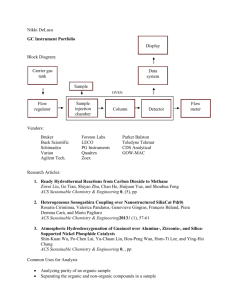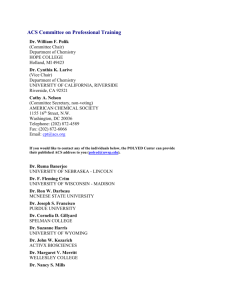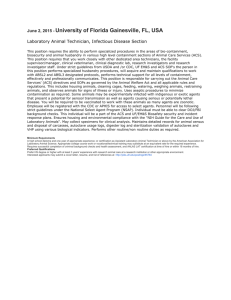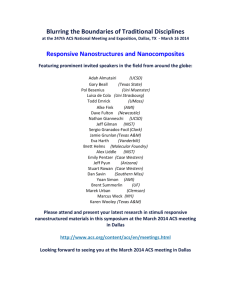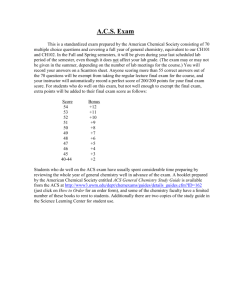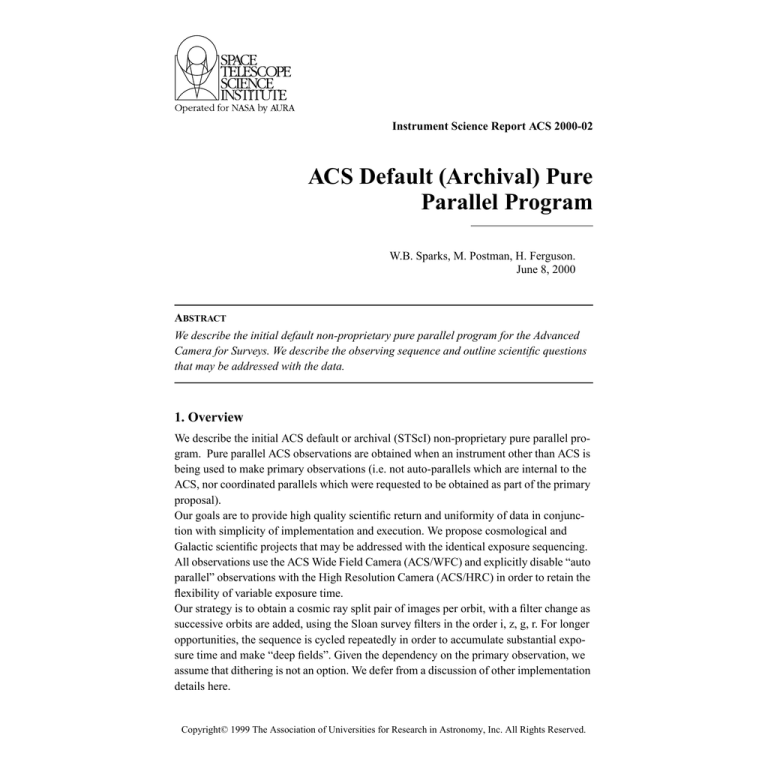
Instrument Science Report ACS 2000-02
ACS Default (Archival) Pure
Parallel Program
W.B. Sparks, M. Postman, H. Ferguson.
June 8, 2000
ABSTRACT
We describe the initial default non-proprietary pure parallel program for the Advanced
Camera for Surveys. We describe the observing sequence and outline scientific questions
that may be addressed with the data.
1. Overview
We describe the initial ACS default or archival (STScI) non-proprietary pure parallel program. Pure parallel ACS observations are obtained when an instrument other than ACS is
being used to make primary observations (i.e. not auto-parallels which are internal to the
ACS, nor coordinated parallels which were requested to be obtained as part of the primary
proposal).
Our goals are to provide high quality scientific return and uniformity of data in conjunction with simplicity of implementation and execution. We propose cosmological and
Galactic scientific projects that may be addressed with the identical exposure sequencing.
All observations use the ACS Wide Field Camera (ACS/WFC) and explicitly disable “auto
parallel” observations with the High Resolution Camera (ACS/HRC) in order to retain the
flexibility of variable exposure time.
Our strategy is to obtain a cosmic ray split pair of images per orbit, with a filter change as
successive orbits are added, using the Sloan survey filters in the order i, z, g, r. For longer
opportunities, the sequence is cycled repeatedly in order to accumulate substantial exposure time and make “deep fields”. Given the dependency on the primary observation, we
assume that dithering is not an option. We defer from a discussion of other implementation
details here.
Copyright© 1999 The Association of Universities for Research in Astronomy, Inc. All Rights Reserved.
Instrument Science Report ACS 2000-02
Note that there is no “special object” component to the archival ACS pure parallel program and the observational strategy is independent of Galactic latitude.
The Cycle 10 Call for Proposals should be consulted for policies and procedures relating
to possible GO applications for pure parallel observing or for uses of the archival pure parallel data.
2. Scientific projects
2.1 ACS as a survey instrument
ACS is a true survey instrument. By design, it is capable of answering important cosmological questions through relatively wide-field deep imaging at high spatial resolution.
Specifically, the camera was optimized for studies of (1) the formation and evolution of
galaxies and clusters of galaxies, and (2) the nature and large scale distribution of matter
in the Universe. Given its unique status on HST as a survey instrument, parallel observations are potentially more important for ACS than other instruments. ACS has wider field
of view, higher spatial resolution and better sensitivity than the WFPC2. In terms of “discovery space” (the product of FOV and sensitivity) it exceeds WFPC2 by a factor of ten,
by design.
The cosmological issues will be addressed using measurements of weak lensing to map
the matter distribution and photometric redshifts and dropouts, color and morphology to
estimate evolutionary effects and the evolution of clustering. The ACS GTO program, for
example, is devoted primarily to a survey targeted at specific galaxy clusters of different
redshifts. Pure parallel observations offer the opportunity to greatly increase cosmological survey exposure time and provide a scientific complement to the GTO program
through field observations rather than clusters.
On the assumption that ACS will take over from WFPC2 as the preferred imaging camera,
and on the assumption that in general, NICMOS observations will be dithered, we conclude that the majority of ACS pure parallel opportunities will be with STIS spectroscopy
prime. This is currently the situation for WFPC2, and, hence, as a model for the distribution of parallel observing opportunities ,we may assume that the WFPC2 experience is
representative. Examination of the available WFPC2 parallel data shows that there are a
significant number of opportunities in excess of 10,000 sec which offers the prospect of
very deep images. Also, well over a (non-contiguous) square degree has been imaged to
lesser depth. That is, the total area on the sky covered by WFPC2 pure parallels of order an
orbit in duration, exceeds a square degree. In one orbit, the effective Sloan-i magnitude
limit for ACS is expected to be slightly fainter than 27. Additional statistics on the existing
parallel programs may be found following the links in http://archive.stsci.edu/hst/parallels/.
With only a single orbit observation, the approximate ACS/WFC point source 5-sigma
flux limits are, for a flat (flambda) continuum:
2
Instrument Science Report ACS 2000-02
Filter
VEGAMAG
ABMAG
SDSS-i
(F775W)
R=27.4
27.7
SDSS-z
(F850LP)
I=26.6
27.1
SDSS-g
(F475W)
B=28.05
27.9
SDSS-r
(F625W)
V=27.8
27.9
These limits are probing to cosmologically useful depths. (The limits are approximate and
do depend on the color of the object, ranging over about 0.5 mag with color extremes.)
2.2 A Weak Lensing Survey Using ACS Pure Parallel Observations
Mapping the large-scale structure (LSS) of the universe is a fundamental goal of modern
observational cosmology. Up until recently, efforts to do this relied upon identifying visible tracers (i.e., galaxies or clusters of galaxies) of the underlying mass distribution and
making the assumption that light traces mass. This approach requires that one understand
all the physical biasing effects that this indirect mapping technique implies and, unfortunately, these are not well understood. It is, thus, much better to trace the mass distribution
directly. This can be done using large-scale weak gravitational lensing where the mass is
mapped by measuring the large-scale correlated ellipticities induced in the images of distant galaxies.
An ACS pure parallel program covering a total (but non-contiguous) area of at least 1
square degree, and to a depth typical of a 1 or 2 orbit exposure, would be able to achieve at
least a 10-sigma detection of the characteristic shear signal on arcmin scales. The detection could be extended to even larger scales, if the field-to-field spacing is ~1 degree or so.
This S/N estimate assumes the background galaxy density is in the range 1 - 2 x 105 galaxies per square degree which corresponds to a limiting I-band magnitude in the range 25 26, which is easily achievable with ACS/WFC in one orbit.
As the area covered in the parallel survey grows, the constraints one can make on the mass
distribution will become more sophisticated. Whereas a 1 square degree survey can firmly
measure the shear, a survey of 5 or more square degrees would allow a tight constraint to
be made on the large-scale angular power spectrum and on omega and lambda. The area
covered by an ACS pure parallel program over the course of 2 to 4 years, based on the historical data from WFPC2, would be in the range 2 to 5 square degrees. ACS is particularly
well suited to such a study because the S/N of the shear signal grows as the square root of
the total area and directly with the number of background sources available. The wide format and high sensitivity of the WFC thus make ACS an ideal detector for this application.
3
Instrument Science Report ACS 2000-02
2.3 Galaxy Morphology and Evolution
Parallel observations obtained in random fields particularly at high Galactic latitude may
be used to study the detailed properties of faint galaxies, specifically their size, color and
morphology in different bands. This program would be able to map the number, angular
size, color, and morphology of galaxies at cosmologically significant redshifts. As additional colors are introduced into the sequence, photometric redshift estimation may be
used for redshifts up to approximately 1. Beyond that, there is the possibility of detecting
galaxies at very high redshift in significant numbers using the “Lyman dropout” technique,
as the flux essentially vanishes below the Lyman limit. The good ACS/WFC spatial sampling in the optical should optimize the ability to achieve star-galaxy separation and
galaxy classification at the faint end of the apparent luminosity distribution.
Armed with knowledge of the number counts and colors, and for a subset, a statistical estimation of the redshifts, we may make progress on studying the evolutionary history of
galaxies and star formation in galaxies, as well as the clustering properties of galaxies as a
function of redshift.
Following WFPC2 and STIS investigations, the ACS default parallel survey will enable
studies of:
•
Study the faint galaxy population, their colors and counts as a function of morphological type, thereby constrain galaxy evolution beyond the levels where it can be
addressed spectroscopically.
•
Study the sub-kpc rest frame morphology and color gradients of faint field galaxies to
constrain stellar populations and dust.
•
Study morphology of galaxies in the rest-frame UV across a wide redshift range to
give a better understanding of the evolution of morphology and star formation properties with redshift.
•
Study morphology, size and color of the numerous, possibly sub-galactic blue compact
objects found at B ~ 24
•
Identify Lyman dropouts. At the magnitudes that can be reached easily such galaxies
will be luminous high-redshift objects, and therefore quite rare. Large, randomly
pointed surveys such as the pure parallel program offer a good opportunity to find
these objects.
2.4 Faint Galactic Stars
Deep parallel opportunities will enable sampling of Galactic star counts with reliable stargalaxy separation as a function of Galactic latitude to constrain Galactic halo/bulge/disk
models. The uniformity of the initial survey will enable an unbiassed census of the Galactic stellar populations to be obtained regardless of Galactic latitude and to substantial
depths.
Opportunities lasting several to many orbits will also provide the opportunity to find faint
stars that are variable on time scales of ~6 hrs down to V=28-29 mag.
4
Instrument Science Report ACS 2000-02
Similarly, any multiple orbit images at low ecliptic latitudes offers the possibility of
detecting faint solar system objects serendipitously through their proper motion.
The objectives for generic low latitude observing will be similar to previous programs search for and identify stars at the low end of the main sequence as well as white dwarfs
(WD). The high sensitivity particularly in the red region of the spectrum where ACS is
optimized, and observations emphasising i and z, will provide a useful diagnostic of latetype and low mass stars, cool white dwarfs and sub-stellar objects to faint limits over a
wide field of view.
The existence of brown dwarfs as a unique class has become a reality; nevertheless the
transition region linking these objects with the lowest mass stars remains largely unexplored in part because of their intrinsically low luminosities (e.g., GL 229B is only 6.4x10
-6 L). Thus, only the nearest examples could have been detected and only small volumes
of sky have been searched. The discovery and characterization of both brown dwarfs and
transitional objects (e.g., GD 165B) as would contribute significantly to such topics as star
formation, physical and chemical processes in the region between stellar and planetary
atmospheres, “dark matter”, and galactic structure.
High Galactic latitude observations will be particularly well suited at identifying the copious population of Halo WD which recent microlensing experiments suggest could account
for as much as 70% of the baryonic dark matter content of the Galaxy. These objects are
expected to have a typical mass of 0.5 Msolar and a colour and magnitude that depend on
their age. An interesting outcome of recent theoretical modelling of WD cooling
sequences is that objects older than ~ 12 Gyr tend to become relatively bluer than at
younger ages. This provides powerful diagnostics to determine the age of the Halo. More
generally, the luminosity function of WD by itself will provide constraints not only on the
age of the Halo, but also on the shape of its IMF below ~1 Msolar, a region of the mass
spectrum which is still plagued by many uncertainties. A robust determination of the WD
luminosity function will represent a key ingredient in our understanding of the star formation process, of stellar evolution, and of the nature and origin of baryonic dark matter.
3. Summary
We have outlined the observational strategy to be employed by STScI in providing an
archival (default) pure parallel program for the ACS. The program should serve to address
a number of important scientific questions, yet remains conceptually simple for implementation and scheduling purposes which should enhance the scientific return through
improved survey coverage, both in terms of areal coverage and depth per pointing. The use
of the standard Sloan system offers benefits for comparison with other ground based surveys, including of course the Sloan survey itself.
5
Instrument Science Report ACS 2000-02
4. Appendix: statement of the specific observations
1 orbit: With one orbit available, we propose taking one CR-SPLIT direct image (i.e. two
images) using the full ACS/WFC camera with the Sloan-i (F775W) filter, the most sensitive of the principle survey filters, matched to the ACS peak response and spatial
sampling, also ensuring commonality with ground based surveys and future WFC3 surveys. The exposure will be tuned to fill the one orbit opportunity to best ability at the time
of implementation.
2 orbits: append a Sloan-z filter (F850LP). High throughput z-band imaging is a new capability that ACS brings to HST. Furthermore it is difficult to obtain z-band imaging of faint
galaxies from the ground due to the brightness of the night sky at 9000A. These z-images
over a large area will be ideal for the study of cosmic shear, the two-point correlation function and galaxy morphologies to faint magnitudes as well as providing photometric
dropout information for galaxies at very high redshift via the Lyman break dropout technique. An elliptical galaxy with the 4000A break straddling the i-z gap has much better
detectability in z, hence offering the prospect of a good search for red, high redshift
objects. The second orbit imaging strategy will be the same as the one-orbit, i.e. a single
pair of CR-SPLIT images.
3 orbits: append Sloan-g image (F475W). The higher blue response of the ACS over
WFPC2 and good spatial coverage will allow for the discovery of large numbers of moderate redshift galaxies via the Lyman break dropout technique. Scaling from the HDF, we
expect to find approximately 13 B-band dropouts per orbit.
4 orbits: append the Sloan r-filter (F625W). Such color information will enable a number
of additional scientific studies such as improved cosmic shear and galaxy-galaxy lensing
as well as a search for galaxy clusters at redshifts greater than one.
More than four; append appropriate sized visits to accumulate mini-deep field observations. All observations to use Gain=4 to improve data compression on-orbit and hence
increase the chances of successful implementation.
6

